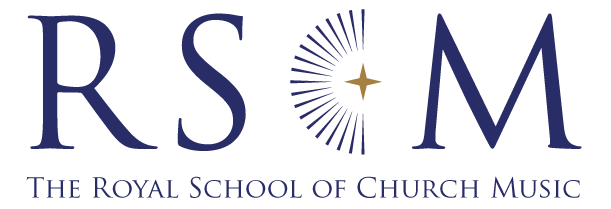Reviews of CDs
* Worth hearing
** Recommended
*** Essential listening
ORGAN CDs
*
CÉSAR FRANCK: THE ORGAN WORKS
Franz Hauk plays the great Klais organ of Ingolstadt Minster, Germany
Priory PRCD 1227
Franz Hauk’s recording from Ingolstadt Minster in Germany offers an interesting overview of the organ works of César Franck (1822–90). Not all of Franck’s works are featured as the title might suggest, but most of the well-known ones are included, in addition to some pieces that had previously been published as works for the Orgues de salon.
Although a little rigid in places, the playing is undeniably skilful, and well executed throughout. Some of the tempi are a little fast, particularly in the Prelude, Fugue and Variation and Pastorale. Whilst the Klais organ of Ingolstadt Minster invokes the necessary drama and power when required, some of the softer, more expressive corners of the recording are let down by the rather dense sound of the foundation stops.
The organ has been captured well by the engineers, which in turn produces a magnificent sound. While the playing might not be for purists, there are certainly many admirable moments and it is worth a listen.
Richard Brasier
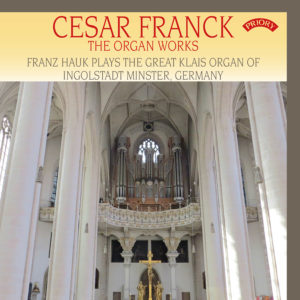
**
ORGAN TRANSCRIPTIONS
AGNUS DEI
Stefan Schmidt plays the great Klais organ of Würzburg Cathedral
Priory PRCD 1224 and 1225
Stefan Schmidt’s recording of Organ Transcriptions, including Oskar Gottlieb Blarr’s arrangement of Mussorgsky’s Pictures at an Exhibition, and Brahms’s Variations and Fugue on a theme of Handel, Op. 24 in an arrangement by Martin Schmeding, is a whirlwind of colour from start to finish. While some of the registrations don’t immediately imitate the sound of a traditional orchestra, they showcase the wonderful variety of colour that the organ offers. The playing is excellent, as is the recorded sound. While this is not the first recording of Mussorgsky and Brahms on the organ, it is certainly up there with the best.
Agnus Dei takes its title from the opening work on the disc, Frank Martin’s arrangement for the organ of his Agnus Dei from the Mass for two choirs. Here we can find a good mix of arrangements and original works for organ, ranging from Bach to Rachmaninoff. The largest work by far on the recording is Reubke’s Sonata on 94th Psalm, which interestingly features at number 13 of a track listing of 15. Again, the playing is vibrant and musical throughout, and deserves to be listened to more widely.
Richard Brasier
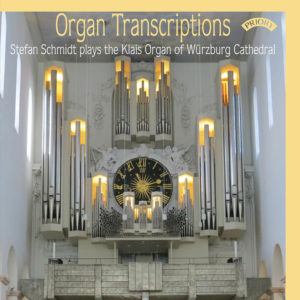
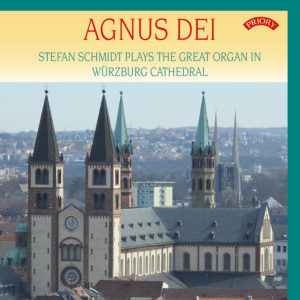
*
GLASGOW BELLS
Kevin Bowyer plays organ music by Alan Gibbs and friends with Dame Evelyn Glennie and Robert Gibbs
Priory PRCD1215
This recording reaffirms Kevin Bowyer’s reputation as a leading interpreter of contemporary organ music, and there is no doubting his commitment to the music of Alan Gibbs. Bowyer has chosen his tempi well and plays to the acoustic demands of the chapel so that the Glasgow University Memorial Chapel organ gets a chance to shine. However, there is a huge range of dynamics in the recording. I had to keep changing the volume levels on my CD player to compensate for the difference between the brightness of Dame Evelyn Glennie’s xylophone in Glasgow Bells and the almost inaudible violin of Robert Gibbs (the composer’s son) in the Tartuffe Suite and 1789 Fragments. The music by the composer’s friends includes the wonderfully atmospheric Sunlit Ambiguity by Bethany Patterson and Anthony Baldwin’s rousing Variations on ‘Kelvingrove’.
Ian Munro
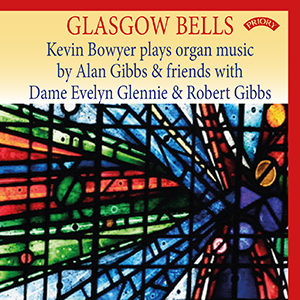
***
FROM THE GROUND UP
David Hill plays the organ of Peterborough Cathedral
Regent REGCD539
This is an attractive and enjoyable recital of music based on or incorporating passacaglia construction by many under-performed composers, played with aplomb by David Hill. The programme has been well thought out with the more substantial pieces interspersed with shorter works. The tempi are well paced and, along with the choice of registrations, suit the acoustic. Every note is audible: in particular, the counterpoint in Alcock’s Introduction and Passacaglia is heard clearly. The cascading semiquavers of Murrill’s Carillon never rush and the rhythm remains clear and crisp. The range of dynamics and the timbres the Hill organ has at its disposal are simply staggering. None of the acoustic problems common with recordings made in a large cathedral are evident here and praise must go to engineer Gary Cole for producing such an impressive disc.
Ian Munro
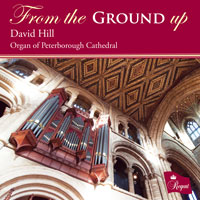
**
THE ORGAN OF ST BARTHOLOMEW’S, ORFORD
Catherine Ennis
Priory PRCD1235
The title of this CD leads with the instrument, a 1976 three-manual mechanical action instrument built by Peter Collins for the Turner Sims Hall at Southampton and now rebuilt in Orford Church, venue for the first performances of Britten’s Noye’s Fludde and his three church parables. But now the CD must be treasured as the final recording by the inspirational Catherine Ennis who died last December. Two preludes and fugues – J.S. Bach BWV 565 and Reger from his Op. 59 Zwölf Stücke – frame 17 other varied tracks. The five movements of de Grigny’s Veni Creator alternate with its plainchant sung by the men of Orford’s excellent church choir. Handel’s F major ‘Cuckoo and Nightingale’ concerto is given in Dupré’s solo organ arrangement. Other works are by Mendelssohn, Brahms, Parry (three chorale preludes), Britten and Dan Locklair. Whether serene or vivacious, Catherine Ennis’s playing is always engrossing – the recording and presentation (liner notes by Graeme Kay, Paul Hale and Ennis herself) are a worthy tribute.
Judith Markwith
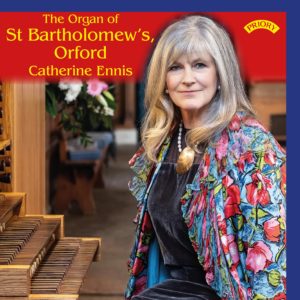
CHORAL CDs
**
BENJAMIN BRITTEN: SACRED CHORAL WORKS
Choir of Norwich Cathedral / David Dunnett and George Inscoe (organ) / Elizabeth Green (harp) / Ashley Grote
Priory PRCD1233
Here we have in one hit a valuable catalogue of Britten’s key sacred works, namely Rejoice in the Lamb, A Ceremony of Carols and the settings of canticles for morning prayer. Then there are the four ‘hymns’ to St Columba, St Peter, the Virgin and St Cecilia. Each is so different – from the rather unsettling (and tricky!) Hymn to St Columba to the simplicity of the Hymn to the Virgin, an early work. Recorded spaciously but very clearly in February 2020, the cathedral choir of boys, girls, men and women is in excellent voice and well balanced. Ashley Grote allows each work to breathe; for instance, the steady pace of the Jubilate in C. Similarly, the ‘instead of thy fathers’ passage in the Hymn to St Peter is not at all rushed and to my mind better for it. There are accompanying notes from Michael Nicholas, former Norwich Cathedral organist, who makes the point that Britten’s writing showed ‘startling originality’. How true!
Stuart Robinson
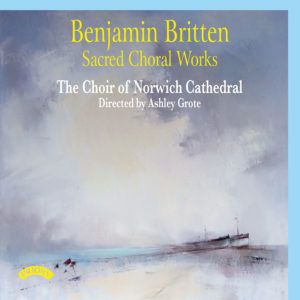
*
LONGING FOR HOME: THE AMERICAN HYMN TRADITION
Choir of St Peter’s Church, St Louis, Missouri / David Sinden
Regent REGCD509
‘This is not hymn singing as you might know it, Jim.’ Well, certainly not if you’re reading this in the UK. The American hymn tradition (as Dr Richard Longman explains in the sleeve notes) began in New England in the early 18th century. On this CD we have what British readers might term ‘hymn anthems’ – strophic texts set for singing by a trained choir. St Peter’s well-balanced mixed choir present 16 settings by 20th-century composers of a range of texts ranging from the African American spiritual Steal away to Jesus to Gerre Hancock’s complex God is ascended. There’s a fine unaccompanied setting by Harold Friedell of George Herbert’s ‘King of glory, king of peace’. This is a fascinating insight into a tradition that has developed considerably ever since the first African American spirituals mingled with metrical psalms and chorales brought over by European settlers. The website stpetersepiscopal.org is worth a visit.
Stuart Robinson
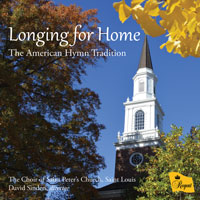
**
A CELTIC PRAYER
Choir of Paisley Abbey / David Gerrard (organ) / Ewan Robertson (bass flute) / George McPhee
Priory PRCD1234
This disc is a wonderful selection of Scottish church music from the Renaissance to the present day. Martin Dalby’s Mater salutaris is sung well and Thomas Wilson’s a cappella setting of There is no rose is divine with the sopranos’ final note floating effortlessly and ethereally. Cedric Thorpe Davie’s The Lord is He whose strength doth make me strong is given a majestic performance. David Gerrard’s organ accompaniment is consistently sympathetic to the choir although the singers’ impeccable diction sometimes is a little lost in the acoustic. Three solo organ pieces, all compositions by George McPhee based on hymn tunes, are exquisitely played. It is a shame that there is no information in the accompanying notes about the abbey’s 1874 Cavaillé-Coll organ. Three Donne Lyrics by Edward McGuire are beautifully sung and the accompaniment of the bass flute is unique yet effective, although sometimes slightly lost in the choral texture.
Ian Munro
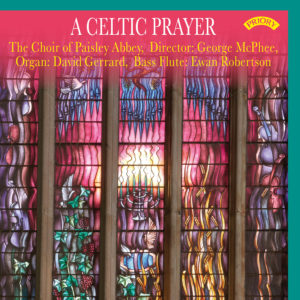
**
IAN VENABLES: REQUIEM
Choir of Gloucester Cathedral / Jonathan Hope (organ) / Adrian Partington Somm SOMMCD0618
An excellent new work receives an excellent performance and recording. Ian Venables has made his name as a composer of songs and this setting of the Requiem Mass is full of detail in its response to the words. The Offertorium is particularly powerful, not least at ‘Libera eas de ore leonis’ where the lion’s mouth is threatening, and towards the end of the movement – after which the inserted Pie Jesu provides welcome repose before an expressive Sanctus. The Libera me is another movement where the terror in the text inspires music of overwhelming power. Adrian Partington’s choir responds with fervour. To complete the disc there are anthems by composers associated with Gloucester: John Sanders, John Joubert, Ivor Gurney and Ian Venables himself.
Judith Markwith
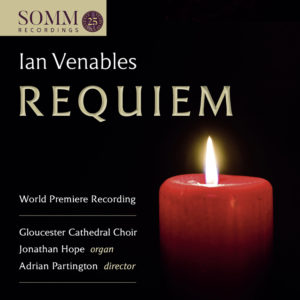
***
VEXILLA REGIS
A sequence of music from Palm Sunday to Holy Saturday
Choir of Westminster Cathedral / Peter Stevens (organ) / Martin Baker
Ad fontes AF002
The recording was made in Buckfast Abbey and with its Ruffatti organ, but it is the Westminster Cathedral singers with their organist and director who provide this insight into the music as it was in the cathedral. The insight comes not only from the recording, but also from two essays: one by Peter Stevens describes Holy Week as he saw it as a musician and one by Jeremy Summerly discusses the music in the context of the Holy Week liturgy. Some of the music is well known and expected: Byrd Ne irascaris Domine and Civitas sancti tui, Duruflé Ubi Caritas, Bruckner Christus factus est, Victoria Improperia, Lotti Crucifixus à 8 and Anerio Christus factus est. But this disc is also valuable for the eight plainchant tracks, sung with generous accompaniment, and for compositions by the cathedral’s own R.R. Terry, George Malcolm and Martin Baker himself.
Judith Markwith
*
CORNHILL VISIONS
A century of musical innovation
Choir of St Michael’s Cornhill / William Morley (trumpet) / Nicola Corbishley (soprano) / Patrick Craig (countertenor) / Colin Huchns (erhu ) / Jeremiah Stephenson, Graham Thorpe, Benjamin Newlove (organ) / Jonathan Rennert Regent REGCD550
Although there are three big Ralph Vaughan Williams anthems here (Lord, Thou hast been our refuge, A Vision of Aeroplanes and Valiant-for-Truth), it is Bax’s 1949 Magnificat, written for Harold Darke and first performed at St Michael’s Cornhill, that has the central place, literally and figuratively. Four anthems by Darke, not easy to find on disc, also give great pleasure. Jonathan Rennert’s 13-strong choir sing musically and without forcing themselves to sound bigger than they are: the result, thanks to singers and director, is subtle and satisfying performances, well captured in the excellent acoustic.
Judith Markwith
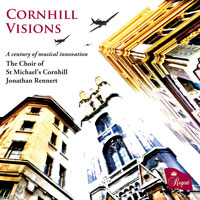
Reviews of printed music
CHORAL MUSIC
E Easy
M Medium
D Difficult
MUSIC FOR HOLY WEEK
ALONE TO SACRIFICE [E/M]
Paul Trepte (and J.S. Bach)
Voices with optional keyboard
Encore Publications £1.95
THE BETRAYAL [M]
Richard Allain
SSATB
Novello NOV297275 £2.25
Paul Trepte sets an English translation of Peter Abelard’s Solus ad victimam for solo voice, to a background of a wordless Passion Chorale that may be sung on any vowel by a choir and/or played on organ or piano. The solo line may be sung by baritone or by a small unison group of voices. So the smallest scoring is solo voice and keyboard and the largest is semi-chorus, SATB choir and optional keyboard. There is flexibility for you! The chorale harmonization (taken from J.S. Bach) is repeated unchanged for all three verses, an effective support for the expressive solo line.
Richard Allain sets a poem by his brother, Thomas, that describes the betrayal of Jesus through the eyes of Judas and offers musical opportunities such as the quiet stillness of upper voices for ‘Amid a voiceless choir of olive trees’ and the drama of ‘Follow with fire, Bring sword and stave’. The harmonic language contrasts open fifths and octaves with scrunchy, added-note five-part chords.\
STABAT MATER DOLOROSA [E/M]
Jean de Castro
SATTB (or AATBarB)
Edition Dohr (Universal Edition) ED20113 £7.50
STILLAE (DROPS) [M/D]
Mårten Jansson
SSATBB
Bärenreiter BA8528 £4.50
Jean de Castro (c.1540–1611) was regarded in late 16th-century Netherlands as second only to Lassus, but has been overlooked since. His setting of the first six verses of the Stabat Mater shows a composer equal in skill to his contemporaries. Beneath the easy flow there is much contrapuntal interest and an increase in tension towards the central verses. Voices are unlabelled – but original clefs are SATTB. The second tenor has a cantus firmus with just the first eight notes of the chant repeated. All the voice parts are low for SATB and might be transposed up a tone for mixed-voice church choirs.
The American poet Charles Anthony Silvestri specializes in texts, often in Latin, for choral composers and here provides a glimpse of ‘drops’ (‘stillae’) of water when Mary bathes her tiny son, of tears of the ‘sorrowful Mother’ pondering her Son’s fate, and of blood at the foot of the Cross. The tight three-line verses contrast with an expansive, at times ravishing, musical setting moving from happiness through grief to despair, before text and music unite in a final prayer. It is an anthem that will enhance Holy Week liturgies.
PALM SUNDAY ANTIPHONS [E/M]
SING, MY TONGUE, THE GLORIOUS BATTLE [E]
arr. June Nixon
SATB
Encore Publications £1.95 each
OMNES AMICI MEI [M]
Ghislaine Reece-Trapp
SATB
Encore Publications £2.50
June Nixon has arranged the plainchant melodies of Pueri Hebraeorum and Pange lingua with English texts for choirs to sing in Holy Week. ‘The children of the Hebrews’ (for Palm Sunday, especially while palms are blest and distributed) grows from cantor through unison men, unison SATB, to five-part SSATB exclamations of ‘Hosanna’, evoking the crying out of the crowd. The four verses chosen from ‘Sing, my tongue, the glorious battle’ alternate unison voices plus organ support (vv. 1 and 3) and SATB unaccompanied (vv. 2 and 4). Throughout both these settings the plainchant is ever present; there remains a feeling of dignity and restraint but with extra musical enhancement from the choir.
Omnes amici mei (‘All my friends have deserted me’, here set in Latin) is the first of the Good Friday Responsories. Ghislaine Reece-Trapp’s setting, despite a feeling that it might have escaped from a volume of early 20th-century anthems, is written with great technical assurance and is notable for the powerful build-ups to its two fortissimo climaxes.
James L. Montgomery
MUSIC FOR EASTER
ANTHEM FOR EASTER DAY [D]
David Goode
SATB with divisions and organ
Colin Smythe Ltd 978-0-86140-503-9 £10.00
This is a luxury publication for a 10-page anthem, but it also includes a 12-page carol (Questions: a lullaby carol), a recording of the anthem and carol, many four-colour illustrations, essays by librettist and composer, biographies of everyone involved – 48 pages of outstanding production quality. For some the CD will be the draw, especially as the anthem is conducted by Stephen Cleobury in one of his final recordings with the choir of King’s College, Cambridge. OxRecs Digital have ensured the highest recording and manufacturing standards. The words, specially written by Francis Warner, are from the viewpoint of Mary Magdalene, ending ‘Just then the gardener spoke one word: my name.’ The music responds to every nuance of the text, moving from a dark-coloured opening to what the composer describes as a ‘gentle conclusion in colour and scents of that new spring dawn.’
CHRIST THE GARDENER [M]
Richard Elfyn Jones
S and B soli, SATB
Encore Publications £2.50
EASTER [M]
Simon Lole
SATB and organ
Encore Publications £2.95
VIDI AQUAM [D]
Matthew Martin
SATB
Novello NOV297453 £2.25
Christ the gardener continues the theme of Jesus’ resurrection seen through the eyes of Mary Magdalene, in this case with soloists for the two protagonists. The poem is by David Broadbridge. The choir acts as narrator and, after a musically exciting repetition of ‘he comes’, also has the final message that ‘Christ we see, but know him not, for Christ may come in any guise to stand unseen before our eyes’ with a triumphant D major finish.
Simon Lole gives himself a challenging task in setting George Herbert’s Easter. For me the most gripping parts are the lively cries of ‘Awake, my lute’ and ‘Celebrate!’, but there is no disputing the power of the opening, nor the well-judged calm (following a tutta forza outburst) of the final prayer.
Vidi aquam (‘I saw water’), the words from the vision of the temple in Ezekiel 47, is sung during the sprinkling with water at the Easter Vigil and throughout Eastertide – and is also suitable whenever water is blest, such as at baptisms. The opening chant-like motif for the two words ‘Vidi aquam’ has a haunting quality and reappears for insistent repetitions of ‘Alleluia’ – the tempo indication ‘calm, gently flowing’ encapsulates the mood.
Stephen Patterson
MUSIC FOR ASCENSION AND PENTECOST
ASCENDIT DEUS [M/D]
Owain Park
SATB
Novello NOV297467 £2.25
O THOU WHO CAMEST FROM ABOVE [E]
SATB and organ
Tim Knight
Knight Edition KE205 £2.20
Owain Park has already made his mark with an Ascensiontide anthem, Caelos ascendit hodie, and follows it with a setting of the better-known text Ascendit Deus. The cue is taken from ‘in jubilatione’ – ‘with a merry noise’ – and rising B flat major scales and rising fourths contribute to this altogether happy anthem.
At the other end of the difficulty scale is a straightforward setting with organ support by Tim Knight of the Pentecost hymn ‘O thou who camest from above’. With a firm crotchet pulse and a forte start, it is a forceful setting, despite a quieter ‘trembling to its source return’. The musical interest is mostly in the organ part that well supports the voices.
James L. Montgomery
ORGAN MUSIC
E Easy
M Medium
D Difficult
MANUALS ONLY
PILNING PICTURES [M]
Tim Knight
Knight Edition KE301 £7.95
This nice volume of contrasting pieces by Tim Knight is usable as either four stand-alone voluntaries or a concert suite. Scored for manuals only, they are a rewarding selection of music to try for organists wanting a break from pedal work or for beginner organists. Dynamics and registrations are clearly marked, but page turns are a problem as they do not occur in easy places. Each movement is only two pages in length, so it is a mystery why the music for each is printed back to back instead of side by side!
CONCERTINO IN C MAJOR [M]
Adrian Connell
Edition Dohr (Universal Edition) ED19029 £9.95
This is an attractive publication with a preface that doubles as a handy programme note; a biography of the composer is also included – always welcome. The music, written for a ‘box organ’, is clearly notated. Registrations are given but not dynamic markings, probably because the box organ’s small size limits its dynamic range. Page turns have been thought out; only in one place do you need to make a turn mid-movement and there the composer provides a suitable opportunity. The four brief movements of this concertino hark back to the classical era. Each movement has its own charm and is a delight to play: an impressive composition and publication.
Ian Munro
For Easter manuals-only music, see also Lothar Graap’s He is risen, Hallelujah! reviewed below.
MUSIC FOR EASTER
TOCCATA ON ‘VULPIUS’ [D]
Dennis Wickens
Fagus-music.com £5.00
Out of an A4 plastic wallet come two sheets of A4 paper with an attractive cover and the composer’s biography, followed by five sheets of thick card on which the music is printed: a ‘build it yourself’ publication perhaps! It at least has the advantage of facilitating page turns. As for the music by Dennis Wickens (1926–2020), it is a fantastic, sprightly, virtuosic but playable toccata on the Easter hymn tune, clearly presented and with registrations left to the performer’s discretion. Both the composition and the publication are professional and of high quality even if for me the presentation doesn’t reinforce that feeling.
Ian Munro
HE IS RISEN, HALLELUJAH! – VARIATIONS ON THREE EASTER THEMES [M]
Lothar Graap
Edition Dohr (Universal Edition) ED18953 £10.95
SEE, THE CONQUERING HERO COMES: INSPIRATION FOR ORGAN [D]
Walther Gleissner
Edition Dohr (Universal Edition) ED18966 £6.50
Although Er ist erstanden, Halleluja!, the first of Lothar Graap’s ‘Easter themes’, is little known in English-speaking countries, the second is Vruechten (‘This joyful Eastertide’), while the third, Heut triumphieret Gottes Sohn, is well known from J.S. Bach’s BWV 630 Orgelbüchlein setting. Written for positive organ (manuals only), these tuneful and well-varied sets of variations will enliven Eastertide services and provide grandeur, even on a small instrument.
Walter Gleissner’s ‘Inspiration’ on See, the conquering hero comes (or with the German hymn text ‘Tochter Zion, freue dich’) has a rather heavy approach to Maccabaeus: by the time we reach three statements of the opening motif presented fortissimo, in octaves and up a semitone each time, I want to rescue the tune and present it in a lighter, Handelian fashion. Instead, it is full-on to the end. But if you like your Handel ‘inspired’ like this, it may be the Easter organ piece for you.
Duncan Watkins
COMPLETE EDITIONS
ORGAN WORKS
Ludwig van Beethoven
ed. Richard Brasier
Edition Dohr (Universal Edition) ED20146 £18.50
Readers of Richard Brasier’s article on ‘Beethoven and the organ’ in Organists’ Review (December 2020) discovered that not only did Ludwig van Beethoven (1770–1827) write for the instrument but he studied and played it at least up to 1792. In this volume we have a Fuga and two Praeludia that Beethoven composed for organ, and new transcriptions by the editor of Beethoven’s three pieces for a mechanical Flötenuhr. The preludes pass through all the major keys – compositional exercises perhaps, but well worth playing. The first of the mechanical organ transcriptions, an Adagio, has an expressive tenderness while the two quicker pieces will appeal to anyone who appreciates Beethoven’s early Bagatelles.
An extensive ‘Afterword’ gives a comprehensive account of Beethoven’s working life as an organist in Bonn, notes about the music, a description of organs in Bonn that Beethoven may have known, and hints on registration. This publication deserves a place in every organist’s library.
Julian Elloway
ANTHOLOGIES
CLEMENTI’S SELECTION OF PRACTICAL HARMONY VOL.1 [M–D]
ed. Andrea Coen
UT Orpheus (Universal Edition) MC52.1 £70.50
Muzio Clementi (1752–1832), known today for his many piano compositions, published in 1801 the title under review ‘for the Organ or Piano Forte’ in four volumes, with over 200 ‘Voluntaries, Fugues, Canons & other Ingenious Pieces by the most Eminent Composers’. The 62 pieces in volume 1 are mainly fugal by some 20 different 18th-century composers, not all of whom are well known, for example Umstatt, Caresana and Perti who each provide just one substantial contribution. A few pieces are extracted from works for stringed keyboard instruments.
The opening seven pages are devoted to the ‘Epitome of counterpoint’ with examples of simple, florid and double counterpoint from Fux, Palestrina, Kirnberger and Martini. There are nine artfully constructed fugues by Albrechtsberger, one based on the ascending and descending hexachord, 13 pieces by Kirnberger, several of which are didactic in purpose, five toccatas and fugues by Eberlin and six fugues by Porpora taken from violin sonatas. The eight pieces by C.P.E. Bach, include two canons and four fugues, each preceded by a free fantasia more suited to the clavichord. J.S. Bach is represented by the Piece d’orgue – here entitled Preludio – and the French Suite in G. The Fantasia and Fuga by Ernst Bach is worth exploring, alternating free and stricter barred sections in the fantasia followed by a well-constructed fugue. Clementi himself arranged the ‘fugue from Mozart’s Requiem’. Several of the pieces demand a high level of technical ability, including crossed ‘hands and quaver passages in octaves in the left hand.
This well-produced volume, with almost 200 pages of music, contains a preface in English describing its purpose, an ornaments table from Clementi’s Introduction to the Art of Playing on the Piano Forte and an invaluable table of sources for each piece. Information on the composers, especially lesser-known ones, would have been helpful. It is a pity that it is so expensive as it contains an excellent selection of pieces for voluntaries, recitals and teaching, with only a few requiring pedals.
John Collins
18 INTRODUCTORY ORGAN VOLUNTARIES [E–M]
NINE MISCELLANEOUS PIECES [E/M–D]
J. Varley Roberts
ed. David Baker and Ted O’Hare
Fitzjohn Music Publications £14.00 and £12.00
John Varley Roberts (1841–1920) spent the first part of his working life as organist at two of Yorkshire’s more prominent musical centres, St Bartholomew, Armley and Halifax parish church. In 1882 he was appointed organist and Informator Choristarum at Magdalen College, Oxford. By all accounts, during his lifetime Varley Roberts was a highly acclaimed choir trainer and composer, so it is a shame that his name no longer holds the lofty position it once used to.
These new editions of his organ music from Fitzjohn Music Publications are welcome indeed. The voluntaries and miscellaneous pieces, typical of their period and style, offer tuneful and colourful material for liturgical or concert use. For teachers, they might also be excellent sight-reading material for their students. There is much to explore across the two volumes, and, if his pieces were played more often, Varley Roberts’s work would certainly hold its own against that of his better-known contemporaries.
SIX CONCERTOS [M–D]
Philip Hayes
ed. David Patrick
Fitzjohn Music Publications £12.00
Philip Hayes (1738–97) held a prominent position among musicians during his lifetime. He was a chorister, and latterly Gentleman of the Chapel Royal, and also held posts at New College and St John’s College, Oxford. In addition to the present collection, he composed 50 anthems, an oratorio, service settings, psalms, glees, songs and an Ode for St Cecilia’s Day.
These six concertos were composed to be played with orchestra, but the solo keyboard parts in the original edition were published in such a way as to allow the keyboard player to perform them without orchestral accompaniment. They are colourful, highly tuneful in places, and an excellent alternative to the work of Hayes’s better-known contemporary, John Stanley. This edition is well presented, with an enlightening preface offering a variety of information ranging from sources used to advice on registration and interpreting ornaments.
Richard Brasier
VIER METAPHERN OP. 2885 [E]
Peter Bares
Edition Dohr (Universal Edition) 28929 £8.95
These Four Metaphors are the last completed works of the prolific and respected German composer and organist Peter Bares (1936-2014). Written in September and October 2010, they are compact, dense and puzzling (in a good way) like short, opaque poems that demand repeated attention and thought. Stripped of all expression and tempo marks (save the first, marked ‘Toccata’), it is touching to see dates marked throughout the text, as the composer marked his progress through his final work almost day by day. Simple but highly rewarding music!
Huw Morgan
